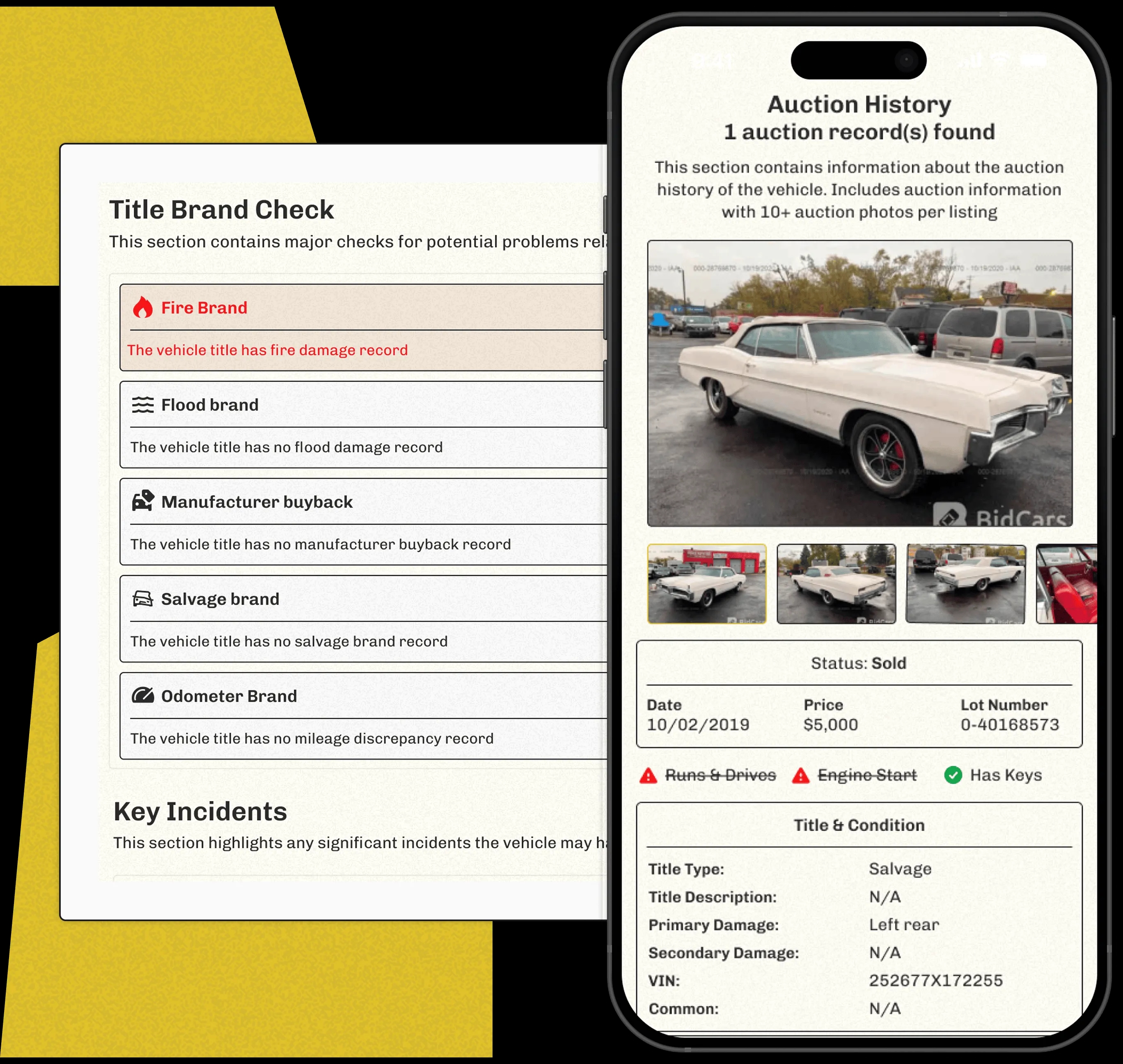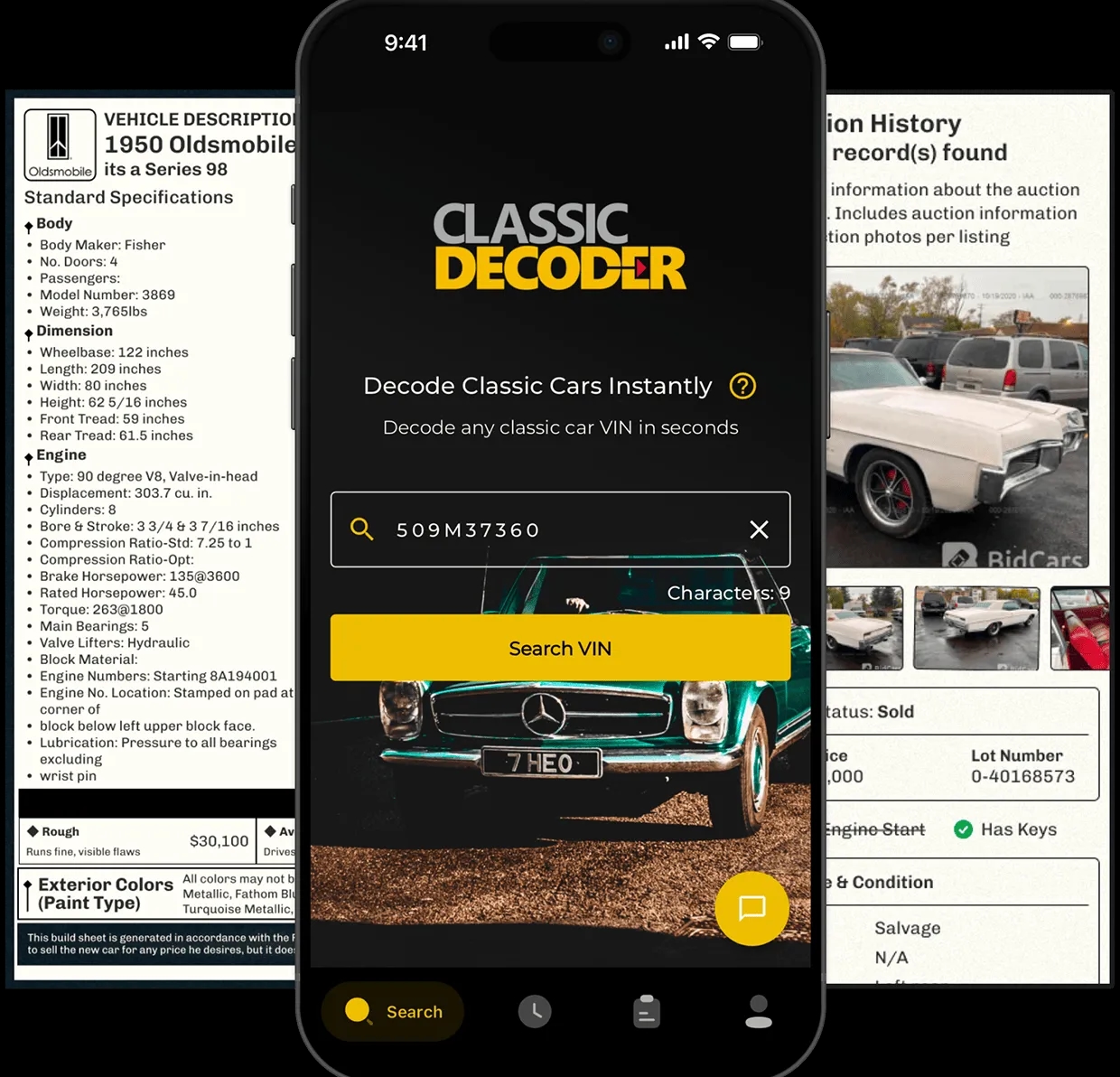1951 Hudson Hornet
The '51 Hudson Hornet: a seriously cool, compact powerhouse! Famous for its NASCAR wins, this car's low-slung, aggressive look and surprisingly strong engine made it a legend. It wasn't just fast, it was a stylish statement, capturing the spirit of post-war America. A true classic!
Decode Classic VINs to Get Vehicle History Report and Build Sheet
History of the Hudson Hornet
The Hudson Hornet raced onto the scene in 1951, a period bustling with innovation post-World War II. Born out of the Hudson Motor Car Company, this car wasn't just about good looks—it was a pioneering force in automotive design. Its unique "step-down" design lowered the vehicle's center of gravity, offering enhanced stability and agility that thrilled performance enthusiasts.
The Hornet quickly made its mark in NASCAR, championed by the unforgettable Marshall Teague. His victories solidified the Hornet's racing prestige and captured America's heart during the booming 1950s car culture era. The public's appetite for stylish yet robust vehicles was insatiable, and the Hornet delivered just that with its cutting-edge features like dual brakes and advanced dashboard indicators.

1951 Hudson Hornet Models:
Select the vehicle's model to see the correct data for it.
How Much is Hudson Hornet Worth?
Original MSRP :$2,568.00
Outstanding
Clean
Average
Rough
1951 Hudson Hornet Specs
Interested in buying a classic car or selling one?
Access detailed history reports for classic vehicles from hundreds of manufacturers.
- Accident Records
- Theft Records
- Loan & Lien Information
- Auction Information
- Salvage Information and more

Famous Figures Who Own the Hudson Hornet
The Hudson Hornet's roar was also the soundtrack to the victories of notable NASCAR heroes such as:
Marshall Teague
A name synonymous with the Hudson Hornet, Teague not only won races but also won hearts. With a track record that boasted wins in 12 of 13 events during the 1952 AAA season, he showcased just how dominant the Hornet could be.
Herb Thomas
Another champion of the track, Herb's steering helped carve the Hornet's legacy further into the annals of stock car racing history. His victories painted a powerful picture of the Hornet's capability—one with speed, charisma, and tenacity.
Dick Rathmann, Al Keller, Frank Mundy, and Tim Flock
These racing legends piloted the Hornet, achieving 27 NASCAR victories that reaffirmed its dominance. These names are etched in the history books, driving the Hornet into realms of legendary status.
Learn more about a classic car: Get Build Sheet by VIN.
Access reproduced classic build sheets to learn more about your classic vehicle details.
- Standard Specifications
- Original Base Price
- Standard & Optional Equipment
- Exterior & Interior Colors
- VIN ID & Location description

Cultural Impact and Pop Culture
Beyond the racetrack, the Hudson Hornet sped into popular culture, notably as the character Doc Hudson in Pixar's "Cars" series. This film not only highlighted its design but immortalized the Hornet as a wise mentor, further embedding it within the tapestry of American life.
Emotional Ties to the Hudson Hornet
The Hornet's cultural journey doesn't stop there. Despite Hudson's production end, the vehicle lives on in the hearts of collectors and enthusiasts. Classics like these serve as timeless echoes of an era defined by innovation and bold designs.
Performance and Records
Known for its impressive speed and agility, the Hornet left competitors in its dust back in the day. With a manual model hitting 0-60 mph in under 14 seconds, it wasn't just about crossing the finish line but doing so with flair and efficiency.
Furthering the Engine's Legacy
Initial builds produced 145 horsepower, which was impressive given the era. By 1954, enhancements pushed this to 170 hp, showcasing the Hornet's capacity for growth and excellence in performance.
1951 Hudson Hornet Gallery


Auction and Investment Insights
The Hudson Hornet not only attracts car enthusiasts but has proven to be a sound investment opportunity. Notably, auction sales have seen figures soar to $220,000, reflecting its enduring appeal. As the car market ebbs and flows, the Hornet consistently reminds us of its solid footing in the collector's arena.
Interested in Buying or Selling a Classic Car?
Owning a classic car is more than just having a set of wheels—it's holding a piece of history. Whether you're buying or selling, a detailed vehicle report is indispensable. Here's why:
Accident Records: Ensure your investment was free from major incidents.
Theft Records: Avoid cars with dubious pasts.
Loan & Lien Information: Check for any existing financial encumbrances.
Auction Information: Understand how it fared in the market.
Salvage Information: Verify that it's never been written off.
For this crucial insight, consider using services like Classic Decoder to uncover the past that each classic car carries.
The Hudson Hornet's legacy is proof that some stories, much like classic cars themselves, never lose their allure nor their capacity to inspire. So whether you're behind the wheel or simply admiring from afar, may the journey always be as thrilling as the destination.
Classic VIN Decoder App |Now available on both Android and iOS!
At Classic Decoder, we believe that developing a mobile app is a great way to extend our classic car data solution hub to as many users as possible across the globe. Our app is built with users and precision in mind. It holds the key to unlocking the history and details of any retro car at your fingertips. It also comes with fascinating and user-friendly features that make it stand out from other mobile apps designed for this purpose.
The Classic Decoder app lets you decode and lookup any classic VIN in a flash. Access accurate vehicle information and history, make an informed decision faster, and buy and trade in classic cars with confidence.

Download The Classic Decoder App now.
Some unique features include:
- Support all classic VIN lengths from 5 to 13 digits
- Support classic cars produced from 1910 – 1980
- Online Garage features – to add and manage your vehicles
- 24/7 Customer Support
- Easy onboarding for first-time users
Explore Hudson Hornet from Other Years
Frequently Asked Questions
Well, the 1951 Hudson Hornet? It's a real looker, let me tell you. Its defining features include that distinctive step-down design—you know, the body seems to hug the ground, which was pretty radical back then. It's like a low-slung sports car, but comfy enough for a road trip, if you get my drift. Then there's the powerful straight-six engine; it was a real screamer for its time, a real beast under the hood. Plus, those iconic fender skirts—they added to that sleek, aggressive profile. It's just a gorgeous car, overall, a real head-turner.
Okay, so, compared to other cars of 1951, the Hornet was a real speed demon. Its engine, as I mentioned, packed a serious punch; it really moved. Think of it like this: it was the muscle car of its day. However, by today's standards? Let's just say it's not going to win any drag races. But hey, it's got character; and that's something you can't buy.
Now this is tricky. The price of a restored 1951 Hudson Hornet? That depends heavily on the condition, you see. A show-quality, concours-ready beauty? That’ll cost you a pretty penny. Think of it like high-end art—a serious investment. But a driver-quality car, one you can enjoy on the open road? That's going to be considerably less. It all boils down to condition and rarity. I'd suggest checking online resources for recent sales to get a more precise estimate. You know, do your homework!
Like any classic car, the 1951 Hudson Hornet has its quirks. Finding parts can be a challenge, sometimes; think of it like a scavenger hunt. Common issues include the carburetor, which can be temperamental. And the electrical system; you know, these old cars; they can be a bit finicky. Then you have the brakes… always a concern with older vehicles. Regular maintenance, of course, and finding a mechanic who specializes in classic cars—that's your best bet. You've really got to find someone who knows these cars inside and out; it's all about finding the right person for the job.
Parts for these beauties can be a bit tricky to find, honestly; but hey, that's part of the charm, right? You'll want to check online classic car parts suppliers; you might have to scour the internet. Plus, there are specialist Hudson parts suppliers, but they're not always easy to come by. And then there’s the whole world of classic car swap meets and forums – those can be treasure troves of parts; sometimes you find hidden gems! It's like a detective story; you gotta put in the time and effort to find exactly what you need.
Ah, yes, the collectability. This is where that legendary NASCAR legacy comes in. The Hornet's racing success; it's practically legendary stuff. It really put Hudson on the map, you know? Then there's its unique styling and that incredible straight-six engine. Put all that together with the relatively low production numbers and you've got a recipe for a desirable collectible. In short, it's a piece of automotive history, a real slice of Americana.

